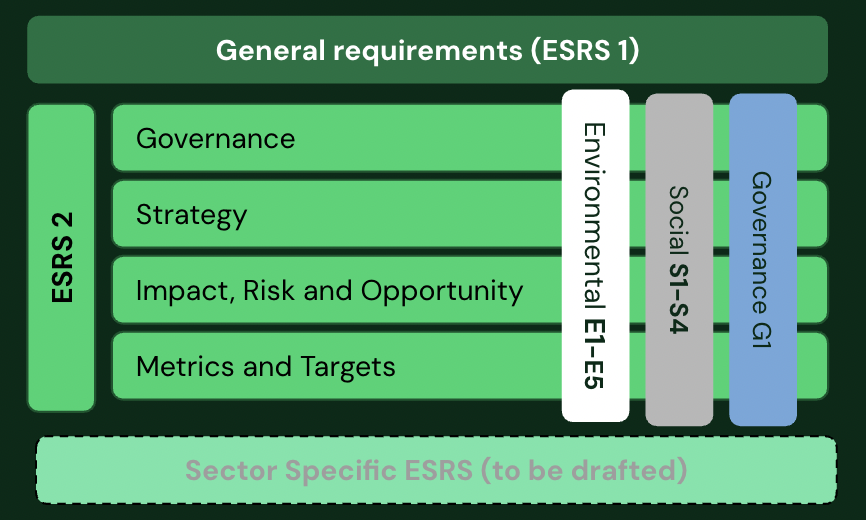.jpg)
Since January 2024, the European Sustainability Reporting Standards (ESRS) have set the framework for sustainability reporting in Europe. This change comes with the Corporate Sustainability Reporting Directive (CSRD) enforcing the first 12 European ESRS, aiming to standardise and enhance the transparency of environmental, social, and governance (ESG) reporting across the continent.
This landmark initiative aims to elevate the rigour and transparency of non-financial reporting to match that of financial reporting, requiring businesses within the CSRD's scope to adopt these standards. The ESRS framework aims to provide a transparent, accurate, and comparable view of a company's ESG impacts, risks, and opportunities. This is not merely a regulatory requirement but a shift towards embedding sustainability into the core of business reporting, reflecting the European Union's commitment to a sustainable economic future.
By demanding detailed disclosure, the ESRS propel companies in Europe and beyond to reassess their sustainability practices and align them with global best practices, setting a new benchmark for corporate accountability and transparency and fostering a more informed and sustainable marketplace for all stakeholders.
The transition to ESRS reporting under the CSRD presents both a challenge and an opportunity for companies. By adopting a proactive approach to understanding and implementing the ESRS requirements, companies can ensure compliance and strengthen their sustainability practices, enhance their corporate transparency, and contribute positively to the global sustainability agenda.
For successful reporting under the ESRS, companies must engage in early preparation and strategic planning. This process entails a comprehensive familiarisation with the extensive scope of the ESRS, identifying any gaps in existing data and reporting processes, and planning to determine the necessary information and workflows for compliant reporting. Early and efficient planning is crucial for companies to align with the ESRS's strict requirements and to leverage this opportunity to meet regulatory demands and demonstrate leadership in sustainability.
This guide supports companies in preparing for ESRS reporting by providing an overview of the standards and outlining practical steps your company can take with Plan A for compliance. By following the outlined steps, companies can ensure they meet all reporting obligations under the CSRD.
The ESRS was developed by the European Financial Advisory Group (EFRAG) and adopted as a delegated act by the European Commission on July 31, 2023. The development of the ESRS is based on two elements:
The ESRS take a “double materiality” perspective, meaning the standards oblige companies to report their impacts on people and the environment and how social and environmental issues create financial risks and opportunities for the company.
A double materiality assessment helps to identify which sustainability topics and ESRS are most relevant (material) to an organisation and its stakeholders.
All standards within the ESRS, except ESRS 2 ‘General disclosures’, are subject to a materiality assessment.

The European Sustainability Reporting Standards (ESRS) serve as the foundation for CSRD compliance, presenting a structured approach for companies to communicate their sustainability initiatives and impacts. Simplifying the ESRS into more digestible terms is vital for better understanding and application.
At their core, the ESRS are divided into two primary categories:
These standards are integral to all organisations aiming for CSRD readiness. There are two standards in this group:
- ESRS 1 clarifies the foundational requirements for CSRD compliance, ensuring companies align with the essential standards of sustainable reporting.
- ESRS 2 expands on this by detailing overarching disclosure requirements that are universally applicable, regardless of the specific sustainability subject matter.
This standard (ESRS 2) delves into three pivotal areas:
These cross-cutting standards act as a compass, guiding organisations on how to structure their disclosures to ensure clarity, relevance, and consistency.
Beyond the foundational requirements, the ESRS offer ten non-mandatory topical standards. These are specialised frameworks that delve into the specifics of Environmental, Social, and Governance (ESG) topics. They are tailored to facilitate topic-specific disclosures, providing a more detailed lens through which companies can evaluate and report their sustainability performance. While not mandatory, these topical standards are critical for organisations to comprehensively disclose their sustainability practices and impacts in specific ESG areas.
Recognising the diverse nature of industries, the ESRS will evolve to include sector-specific standards. These are anticipated to be finalised and adopted by the European Commission by June 2026. These standards aim to address the unique sustainability aspects and reporting needs inherent to different sectors, ensuring that reporting is as relevant and insightful as possible.
In essence, the ESRS is designed to provide a clear and comprehensive framework for sustainability reporting. They are not just a checklist but a transformational approach to integrating sustainability into the very fabric of corporate strategy and communication. This systematic categorisation and the impending sector-specific standards underscore the EU's commitment to tailored, transparent, and transformative sustainability reporting.
Does your company meet the threshold requirements of CSRD? Get ahead now with Plan A to prepare for reporting under the ESRS.
Embarking on the path to sustainability reporting under the new European Sustainability Reporting Standards (ESRS) can seem challenging. However, with the right guidance and strategic planning, your company can transition smoothly and efficiently. Here's how Plan A can ease your journey to compliance in five simple steps:
Are you ready to comply with the CSRD? Plan A is here to support your readiness. Don't wait until the last minute to prepare. Book a demo today and take the first step towards seamless CSRD compliance.